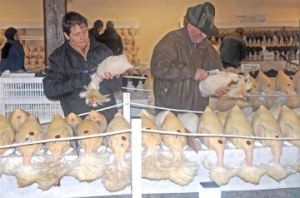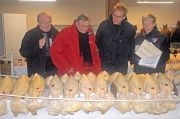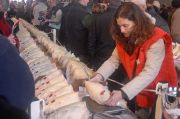 |

|
 Glorieuses / Louhans © T. Joly Glorieuses / Louhans © T. Joly

|
A gastronomic benchmark, Bresse poultry is raised according to traditional methods ensuring top quality and is considered the queen of poultry. Every year in December, four towns host fairs gathering together farmers who present and sell their finest birds.
[ Practical ]
Getting there
- By road
380 km from Paris to Louhans on autoroute A6 till Chalon-sur-Saône, then on N73 till Louhans.
- By train
TGV from Paris Gare de Lyon to Dijon or Bourg-en-Bresse, then TER till Louhans. The journey takes between 3 and 4 hours.
Lodging
- Hotels
Moulin de Bourgchâteau
Hostellerie du Cheval Rouge
Hôtel du Jura
Hôtel La Poularde
- Bed and Breakfast
La Ferme des Fourneaux in Saint-Usuge, 6 km away.
Restaurants
Hostellerie du Cheval Rouge
Hôtel La Poularde
L’Arlequin
Le Saint-Jean
Getting around
A car is necessary if you want to go to a poultry farm
Les Glorieuses 2018
Bourg-en-Bresse : December 14th
Louhans : December 15th
Pont-de-Vaux : December 16th
Montrevel-en-Bresse : December 18th
www.glorieusesdebresse.com
Information
- Bresse poultry
www.pouletbresse.com
- Bresse Bourguignonne Tourist Office
Tel : 0385750502
www.bresse-bourguignonne.com
- Bourgogne Tourist Office
Tel : 0380280280
www.bourgogne-tourisme.com
A former province of France spanning over south of Burgundy and north of Rhône Alpes, the Bresse is every year in December the scene of events called Les Glorieuses. Contrary to what their name suggest, they don’t commemorate heroic battles, revolutions or brilliant victories. They are competitions and fairs devoted to Bresse chicken, the only breed in the world to have been granted an A.O.C. (Guaranteed Origin Appellation), in 1957.
 International fame International fame
So, belonging to the Bressane race whose main characteristics are a red comb, white feathers and blue legs, the birds must be reared within a roughly 100 km long and 40 km wide territory encompassing the south of Saône et Loire, the north of Ain and a fringe of Jura. They are considered the world best poultry and enjoy international fame from Europe to Asia and Japan where they are highly rated by chefs and food critics.
Why ?... Because traditional farming methods give these birds a unique quality with rich flavor, fine tender flesh and delicious bright yellow fat.
Chickens are indeed raised for at least four months and spend a good amount of time outdoors on grass areas where they can hunt for insects, larva and worms making up to one third of their diet.
 Fattened hens and capons Fattened hens and capons
And the rest of their food regime exclusively consists of wheat and white maize grown locally as well as of 5% of milk. Then, to complete the fattening process and tenderize the muscles, the birds are kept calm and still in a wooden cage called “epinette” for the last 10 days of their life. As to the fattened hens and the capons - male castrated at 6/8 weeks to develop muscular mass -, they are respectively raised for at least five and eight months and kept in epinette for three and four weeks.
In addition fattened hens and capons are wrapped tightly in linen or cotton cloth ensuring not only a fine conformation, but also distributing the fat equally around the body as this corset is stitched on as soon as possible after slaughter whilst the body is still warm. In the old days, this practice helped preserve it, when there were no cold rooms.

 Judges / Glorieuses / Louhans © T.Joly Judges / Glorieuses / Louhans © T.Joly
|
 Showcase of the Bresse poultry Showcase of the Bresse poultry
Nowadays, no other poultry producers do this, but this quality has a price. Expect to pay €12 per kg for a Bresse chicken whose origin is guaranteed by an identity ring placed on the left foot.
Held since 18652, Les Glorieuses are the showcase of the Bresse poultry and now take place in four towns : Louhans, Bourg-en-Bresse, Montrevel-en-Bresse and Pont-de-Vaux. Nothing but the best is entered as it is for the farmers the opportunity to prove their know-how and to attract the attention of the great chefs who regularly attend these events. Only accessible to the farmers and the judges – former farmers, vets, chefs, butchers - the competitions are usually held on the morning and start in the early hours of the day with the producers carefully unwrapping their birds. As to the markets, of course open to the public, they start at the beginning of the afternoon with the proclamation of the results of the competition and the prize giving ceremony.

 Glorieuses / Louhans © T.Joly Glorieuses / Louhans © T.Joly
|
 Sold out within a few hours Sold out within a few hours
Then locals and gastronomes rub shoulders and crisscross the alleys to buy their Christmas poultry and the several hundred of chickens, flattened hens and capons are sold out within a few hours.
Besides, about thirty out of the two hundred farmers producing Bresse poultry slaughter and sell birds at the farm all year round. About sixty others do the same in December only when are marketed almost all capons and fattened hens.
On the occasion of Les Glorieuses, each town offers various animations such as Burgundy wine tasting, markets of local specialties, traditional meals and sometimes guided tours of the competitions allowing to watch judges having a close look at the poultry. At Louhans, cooking lessons centered on the Bresse chicken are also on the agenda and take place in a former typical Bresse farm, the Grange Rouge, at La Chapelle Naude.
 Cultural touch Cultural touch
If you want to add a cultural touch to your gastronomic trip, this town from south Burgundy boasts a few interesting sights including its main street, the Grande Rue, where old houses with wooden and stone pillars form a alignment of 157 arcades. The Hôtel Dieu, the former hospital, is definitely worth a look as the two patients rooms are still furnished with enclosed wood beds while its old apothecary, decorated with Louis XIV woodwork, holds a rare collection of Hispano-Moresque and Nevers china pots dating back from the 15th and 16th centuries. Lastly, a branch of the Bresse Bourguignonne eco-museum is set up in the building of the former local newspaper, L’Indépendant, that closed down in 1984 after a century of existence. It shows how a newspaper was edited and printed in the mid-twentieth century and the old printing shop still contains linotype machines, rotary presses and other presses in working condition. It is the only complete printing shop using the lead technique still in existence in France.
October 15, 2018
Thierry Joly 

|



